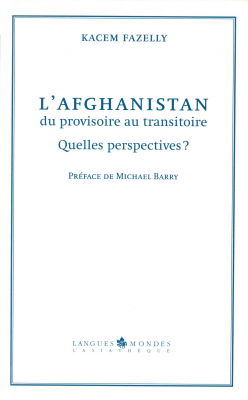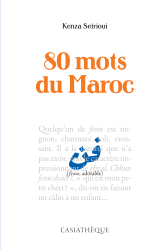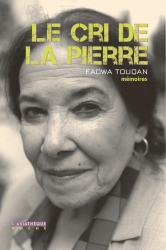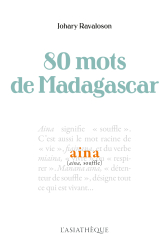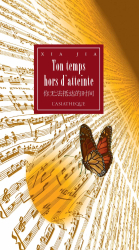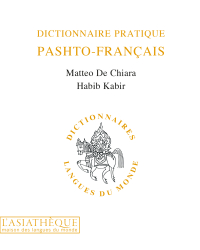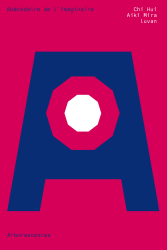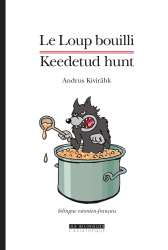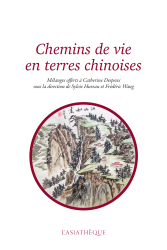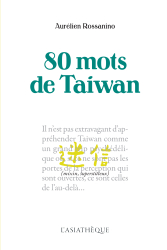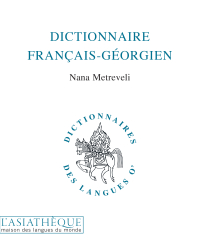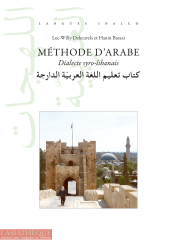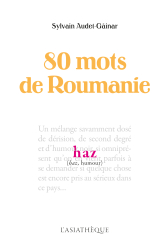Details
Format: Paperback
ISBN: 9782915255164
Collection: Hors Collection
13.5 x 21.6 cm
Weight: 324 gr
Pages: 256
First publication: 12/10/2004
Last printing: 10/2004
CLIL: 4039
BISAC: SOC008070
Kacem Fazelly, professor of law in Kabul and then at Paris I Sorbonne and Paris V René-Descartes, has rubbed elbows with and counseled some of the major players in Afghani politics - especially Mohammed Zaher Chah, the former king, and the new president Hamed Karzai. Fazelly traces the recent past of Afghanistan and poses important questions about its future. Biographical sketches of the diverse personalities currently on the political scene and a helpful glossary complete the volume, making the book a valuable instructional tool. The volume is accompanied by a map of Afghanistan.
CONTRIBUTORS' BIOGRAPHIES
Kacem Fazelly

Kacem Fazelly was born in 1932. He was a professor of law in Kabul, then lecturer at Paris I Sorbonne and Paris V René-Descartes, Kacem Fazelly worked with and advised some of the major players in Afghan political life - Mohammed Zaher Chah, the former king, and the new president Hamed Karzai in particular. Today Ambassador of Afghanistan in the UNESCO, he retraces the past close to his country and wonders about the future.
Michael Barry
Michael Barry is a French-speaking and Persian-speaking American writer. Professor in the Department of Near Eastern Studies at Princeton University, and until recently professor at the American University of Kabul which he was forced to leave, as well as former consultative chairman of the Department of Islamic Art at the Metropolitan Museum of Art in New York, he is an internationally recognized specialist in Persian miniature. Particularly concerned by Afghanistan, the tragedies of which he has experienced closely within Médecins du Monde missions and as head of humanitarian teams in the field, in 1989-1990, for the United Nations, Michael Barry is the author of numerous works on Islamic art, and on the history and geopolitics of Afghanistan.
We can quote among his works (in French):
Faiences d’azur, Impr. Nationale, 1995,
Massoud, de l’islamisme à la liberté, Louis Audibert, 2002,
L’Art figuratif en Islam médiéval, Flammarion, 2004,
Le Royaume de l’insolence : l’Afghanistan, 1504 – 2011, Flammarion, 2011.
Photo : © Cole Bunzel.
TABLE OF CONTENTS
Préface de Michael Barry (Preface by Michael Barry)
Avant-propos (Foreword)
Introduction
De Rome à Petersberg (From Rome to Petersberg)
I. La tenue d’une loya djirga, dernier recours pour résoudre la crise (I. Holding a loya djirga, a last resort to resolve the crisis)
À l’extérieur : (Outside :)
— La réticence pakistanaise (— Pakistani reluctance)
— L’embarras iranien (— The Iranian Embarrassment)
— La disponibilité saoudienne (— Saudi availability)
À l’intérieur : (On the inside :)
— La réticence des talibans (— The reluctance of the Taliban)
— La participation du Front islamique uni (— The participation of the United Islamic Front)
II. Les difficultés soulevées par l’organisation de la loya djirga (II. The difficulties raised by the organization of the loya djirga)
III. L’ambiguïté de la démarche de Rome : combat politique ou moyen de légitimation et de retour à la paix (III. The ambiguity of Rome's approach: political combat or a means of legitimation and a return to peace)
IV. La situation à la veille du 11 septembre (IV. The situation on the eve of September 11)
— La contribution de Zalmai Khalilzad (— The contribution of Zalmai Khalilzad)
— L’ouverture vers le Front islamique uni et la création de structures communes (— Openness to the United Islamic Front and the creation of common structures)
— Le plan de mobilisation politico-militaire du commandant Abdul Haq (— The politico-military mobilization plan of Commander Abdul Haq)
La réunion de Petersberg – les accords de Bonn (The Petersberg meeting – the Bonn agreements)
I. Une conférence internationale pour une gouvernance des Nations unies (I. An international conference for United Nations governance)
II. Les participants à la conférence de Bonn (II. The participants at the Bonn conference)
III. L’esprit des accords de Bonn (III. The spirit of the Bonn agreements)
IV. L’abandon du conseil intérimaire (IV. The abandonment of the interim council)
V. L’effacement de l’ancien roi (V. The erasure of the former king)
VI. L’installation de l’Autorité provisoire et sa pérennisation (VI. The establishment of the Provisional Authority and its sustainability)
VII. La succession des transitions (VII. The succession of transitions)
VIII. Les garanties internationales de sécurité (VIII. International security guarantees)
La loya djirga d’urgence (The emergency loya jirga)
Un rappel historique : une institution contestée mais ressuscitée (A historical reminder: an institution contested but resuscitated)
I. Ouverture et retrouvailles (I. Opening and reunion)
II. Le discours et l’abdication (II. The speech and the abdication)
III. Le déroulement de l’assemblée (III. The proceedings of the meeting)
IV. L’entrée en scène des djihadistes (IV. The entry of the jihadists)
V. Le dénouement (V. The outcome)
L’Administration transitoire issue des accords de Bonn (The transitional administration resulting from the Bonn agreements)
Constats préliminaires (Preliminary findings)
I. L’héritage de l’islamisme radical (I. The Legacy of Radical Islamism)
La survivance des djihadistes : comment se situent-ils ? (The survival of the jihadists: how are they situated?)
— L’interférence étrangère (— Foreign interference)
— Le projet de société (— The social project)
— La réaction à l’égard des accords de Bonn (— The reaction to the Bonn agreements)
La résurgence des talibans : l’exacerbation de l’islamisme radical (The resurgence of the Taliban: the exacerbation of radical Islamism)
— Les fondements théologiques (— Theological foundations)
— La pratique politique (— Political practice)
— Les diverses approches conceptuelles (— The various conceptual approaches)
• L’approche conceptuelle à visée coloniale (• The colonial conceptual approach)
• L’approche conceptuelle à résonance ethnique (• The conceptual approach with ethnic resonance)
II. La démarche de légitimation de l’État (II. The process of legitimizing the state)
Les obstacles aux renforcements de l’Autorité centrale (Obstacles to strengthening the Central Authority)
— La gouvernance à base élargie introduite par les accords de Bonn (— Broad-based governance introduced by the Bonn agreements)
— La persistance du pouvoir des « seigneurs de guerre » et l’ambiguïté qui les entoure (— The persistence of the power of “warlords” and the ambiguity that surrounds them)
— Les démarches fédéralistes (— Federalist approaches)
— Ismaïl Khan et l’émirat de Hérat (— Ismail Khan and the Emirate of Herat)
La légitimation de l’État et la multipolarité du pouvoir (The legitimation of the state and the multipolarity of power)
— Le lieu de légitimation : l’Arg (— The place of legitimation: the Arg)
— La dynamique de légitimation (— The dynamics of legitimation)
— La couverture royale (— The royal blanket)
— La guerre larvée à l’intérieur de l’Administration intérimaire (— The hidden war inside the Interim Administration)
— L’émergence du fondamentalisme du corps des oulémas (— The emergence of fundamentalism in the body of the ulema)
III. La gouvernance par tandems (III. Governance by tandems)
— Le tandem Karzai-Shinwari (— The Karzai-Shinwari tandem)
— Le tandem Karzai-Khalilzad, ou Khalilzad-Karzai (— The Karzai-Khalilzad tandem, or Khalilzad-Karzai)
— Le tandem Karzai-Brahimi (— The Karzai-Brahimi tandem )
— Le tandem Karzai-Fahim (— The Karzai-Fahim tandem)
IV. La place réservée à l’ancien roi (IV. The place reserved for the former king)
La loya djirga de la constitution (The Loya Djirga of the Constitution)
I. La tenue de la loya djirga ( I. The dress of the loya djirga)
— Une djirga sous haute surveillance internationale (— A djirga under high international surveillance)
— Une djirga à forte interférence fondamentaliste (— A djirga with strong fundamentalist interference)
— Une djirga sans débat (— A djirga without debate)
— Une djirga dominée par des revendications culturelles et religieuses (— A djirga dominated by cultural and religious claims)
— Une djirga à résonance ethnique (— A djirga with ethnic resonance)
— Une djirga qui met fin à la monarchie (— A djirga that puts an end to the monarchy)
— L’enseignement à en tirer (— The lesson to be learned)
II. La constitution (II. The Constitution)
L’élaboration (The development)
— Un travail en deux phases (— A work in two phases )
— Un travail dominé par des juristes-théologiens (— A work dominated by jurist-theologians)
— Un travail à concertation élargie mais illusoire (— Work involving broader but illusory consultation )
— Un travail noyauté et dirigé (— Core and directed work)
Le contenu (The contents )
— Un régime politique hybride (— A hybrid political system )
— Une intégration internationale mal assurée (— Uncertain international integration )
— La « chariatisation » de la loi (— The “chariatization” of the law )
III. L’épreuve décisive : le verdict des urnes (III. The litmus test: the verdict of the polls)
Conclusion (Conclusion)
— Le pluralisme et la démocratie (— Pluralism and democracy)
— La survivance des djihadistes et le retour des talibans (— The survival of the jihadists and the return of the Taliban)
— La légitimité de la présence militaire internationale (— The legitimacy of the international military presence )
— Propositions (— Proposals)
Quelques dates clés (Key Dates)
Notices biographiques (Biographical notes)
Carte de l’Afghanistan (Map of Afghanistan)
Glossaire (Glossary)
